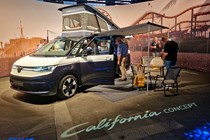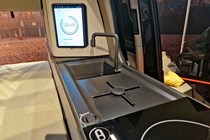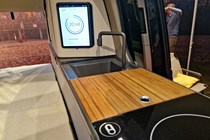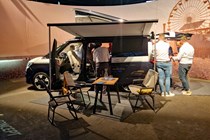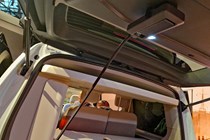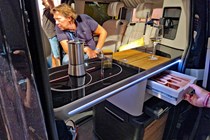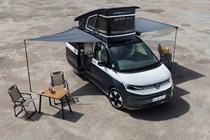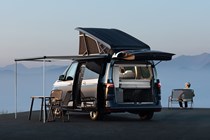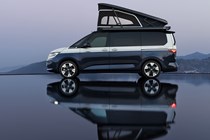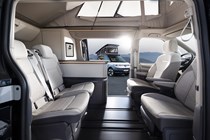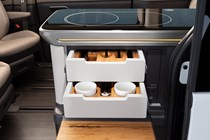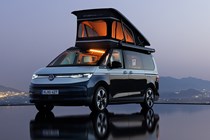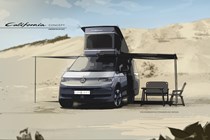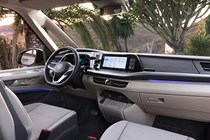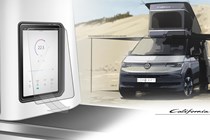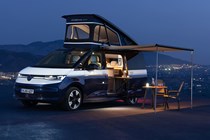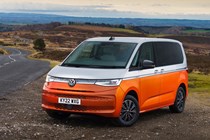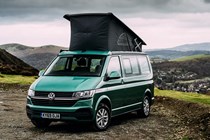Volkswagen is calling this a concept, but you can be fairly certain that this is almost exactly what the next-generation VW California will look like when it goes in sale in 2024. This new T7 California Concept, revealed at the 2023 Dusseldorf Caravan Salon, builds on decades of Volkswagen campervans to blend familiar features with some new ideas. At least one of which is likely to go down very well with UK buyers.
This time around, the new California camper will be based on the VW Multivan people carrier, rather than the Transporter van. This might upset a few purists, but from our perspective you’ll certainly be getting an improved driving experience, as well as access to modern powertrains – including a plug-in hybrid for the first time.
What’s so great about the switch to a Multivan-based California campervan?
For starters, being based on the long-wheelbase Multivan makes this a longer and wider vehicle than the T6.1 California it’s set to replace – meaning more space inside.
But what’s most exciting is that the Multivan comes with two sliding side doors as standard, which means for the first time a factory-built VW camper will also come with two sliding side doors.

This means UK buyers will be able to access the back of the vehicle from the left side, which is usually closer to the pavement. With every previous California you’ve been forced to turf the kids out into traffic (or get them out through the front passenger door via the cab).
That isn’t just good news in this respect, however. It also makes for an airier camping experience, with VW suggesting buyers will be able to make more of the outside space as a result. Underlining this, the T7 California Concept comes with an awning on each side as well – a traditional wind-out item on the left and a sun sail on the right.
For the production version, buyers will be able to chose which side they want the full awning, or even have two.
If there are two sliding doors, where is the kitchen in the T7 California Concept?
Since the kitchen area used to start at the pillar behind the front door on the left, VW has been forced to do a bit of clever thinking here.
There are still kitchen units adjacent to the rear seating area, but they don’t extend all the way across the door opening – instead there’s a pull-out section at the top which extends to reveal access to the sink and gas hob when you’re parked up and it’s all required.
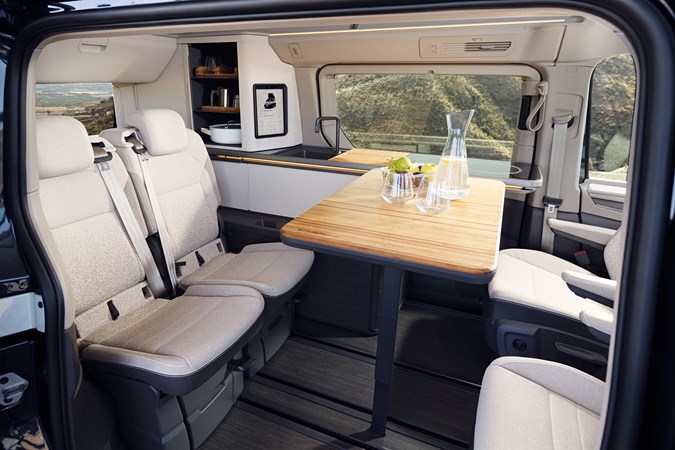
The means you can access the cooking facilities from the outside, so in the future, rather than being confined to the California’s interior, you could be cooking under the stars – or, being the UK where it rains a lot, the awning.
Beneath this section you’ll also find a drawer-style fridge, similar to that fitted to the larger Grand California. As with the new hob, this can be accessed inside and outside the vehicle.
What about seating and sleeping arrangements?
As per previous Californias, the T7 concept has a pop-up roof with the taller section at the front (in contrast to the Ford Nugget, which has the tall part at the rear).
Up here you’ll find a quality, sprung sleeping environment with LED lighting, USB-C sockets and panoramic mesh windows (which can be closed up for privacy, of course).
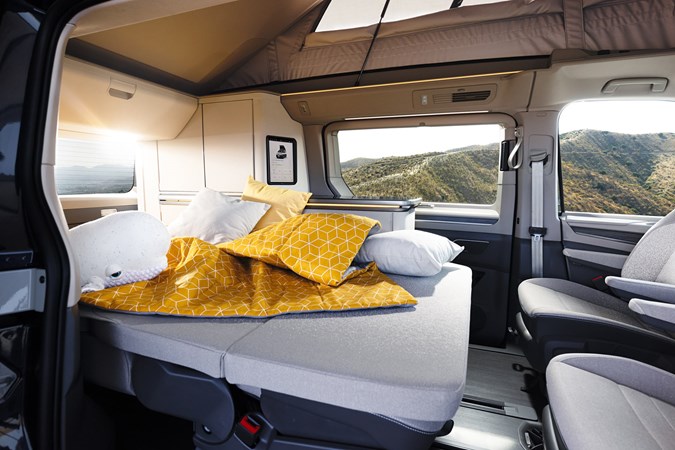
The downstairs sleeping arrangement uses the rear seats, which fold flat to create an area suitable for the included mattress. In a change from previous Californias, these rear seats are now individual items rather than a bench. This means they can be positioned in a line or removed more easily, to better accommodate leisure equipment such as mountain bikes or to turn the T7 California into a capacious load-lugging van.
When the lower bed isn’t needed, there’s an indoor lounge area adjacent to the kitchen, completed by a table (the same one that’s used outside; it slides into a slot on the side of the kitchen area and is stowed under the bed in the boot when not needed) and the front seats, which swivel to face the rear.
As is traditional, the T7 California concept also packs in outdoor chairs for alfresco dining and socialising. These are aluminium-framed and have taller backrests than before for greater comfort. They are stored in the tailgate as usual, although there’s only room for two in there.
Any other innovations?
There’s a tablet-style control system (it’s actually an iPad on the concept) for all of the camping functions – including the powered roof.
If it’s too much of an effort to unhook that from the wall where it’s mounted on a multi-directional arm you can also use a smartphone or the infotainment system in the front of the vehicle.
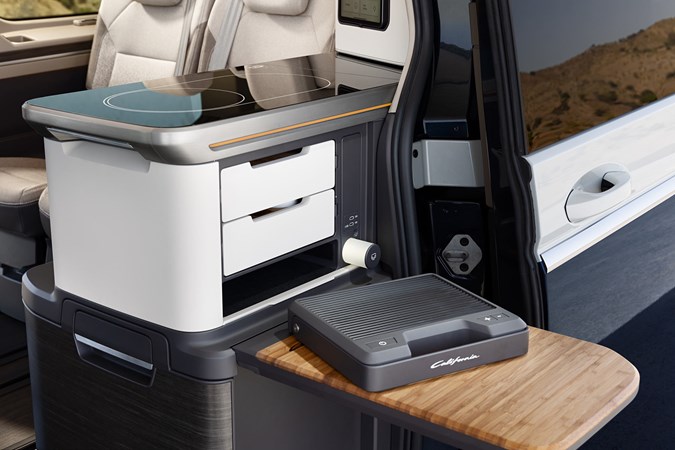
Opt for the plug-in hybrid powertrain (more on this below), and you can use the lithium-ion battery to power 12v devices. This frees you from the constraints of campsites with hook-up electricity, but we’d have liked to see this power some proper plugs as well. The induction hob and the fridge both rely on a 230v supply, for instance.
Having a gas hob onboard as well means you’re not completely restricted to cold food when 230v isn’t available. An electric portable grill is also integrated into the design, allowing you to cook outside away from the living quarters.

Speaking of being outside, the concept has an outdoor shower as well. Other neat details include the double-sided panels that hide the gas hob and the sink, which are wooden chopping boards on one side and glass to act as trivets on the other.
There’s a portable camping light and a spice rack hidden in the storage, while the drawers can be accessed from inside and outside, and will open even when the lower bed is deployed.
Tell us more about the plug-in hybrid
The Multivan is available as plug-in hybrid electric vehicle (PHEV), and the T7 California Concept makes good of use of this to provide a short amount of electric-only driving alongside a petrol engine to take care of longer distances.
We’ve quizzed VW about this, and it insists the California will have the same 30-mile electric range as the regular Multivan. The weight of the camper conversion is offset by the removal of some of the seats.
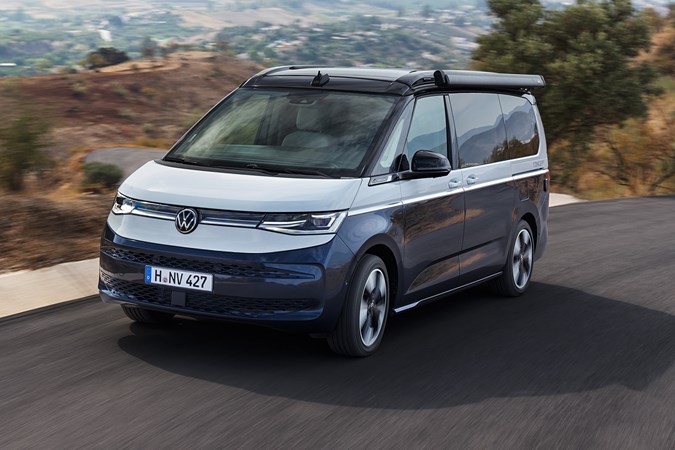
Regardless, a PHEV California makes sense as a stepping-stone to full electric camping mobility, which is set to appear in the ID. California in the next couple of years.
It would also have given the T7 California a unique selling point, except that Ford has also chosen the 2023 Dusseldorf Caravan Salon to reveal the production (not concept) version of the next-generation Nugget campervan, which will also be available as a PHEV in 2024.
When does the T7 California go on sale?
VW is openly calling this a ‘near-production’ concept vehicle and has stated that the T7 California will be on sale in 2024 – taking the fight directly to the new Ford Nugget. You can read about how this turned out previously in our Nugget vs California twin-test.
As has been the case for several generations, the California is designed and built entirely by Volkswagen, however, with all the quality and defined standards this entails. The Nugget remains a vehicle built in partnership with Westfalia; the unusual rear-kitchen layout of the Ford remains as well.
Whichever you favour at this stage, it looks like 2024 will be an excellent time to go shopping for a new camper.
VW has told us that Beach versions of the T7 California will be offered in time as a lower-cost model without a kitchen. Five and seven-seater variants of this are promised, with the option to add a kitchen pod at the back also likely.
Just so you know, we may receive a commission or other compensation from the links on this website - read why you should trust us.



